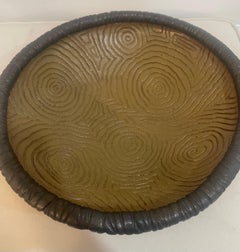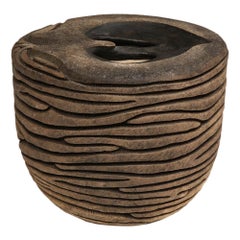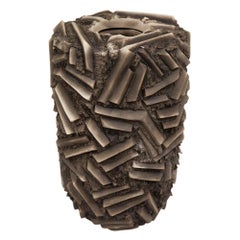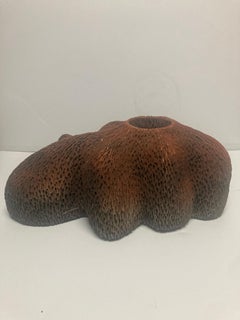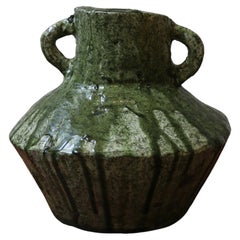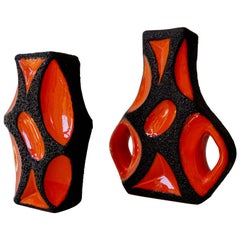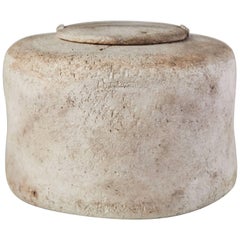Rob Sieminski
to
2
5
4
2
1
1
1
1
Rob Sieminski Nail Encrusted Pottery
By Rob Sieminski
Located in West Palm Beach, FL
A fine example of this artists finest
work.
Rob Sieminski is a Maine Studio Potter.
He is represented in a number of institutional collections including:
Philadelphia Museum of Art
S...
Category
Early 2000s American Rob Sieminski
Materials
Pottery
“Pottery Bowl”
By Rob Sieminski
Located in Warren, NJ
This is a rob sieminski pottery bowl stamped in the bottom. In good condition . Measures 17x5
Category
20th Century Rob Sieminski
Materials
Ceramic
Rob Sieminski Ceramic Vase, Hand Built, Sculpted, Brown, Signed
By Rob Sieminski
Located in New York, NY
Rob Sieminski vase, ceramic. Large chunky hand built, smoke fired, double walled vessel with incised carved decoration on the outer shell and a heart shaped double opening on the top. Signed with the artist's cipher on the underside: 3 rectangular impressions.
Rob Sieminski is a full-time potter living in the western mountains of Maine. He has taught ceramics at the Whitemarsh Art Center (PA), the University of Delaware, the Maryland Institute of Art, and West Chester...
Category
1990s American Modern Rob Sieminski
Materials
Ceramic
$1,440 Sale Price
60% Off
Rob Sieminski Ceramic Vase, Hand Built, Sculpted, Earth Tones
By Rob Sieminski
Located in New York, NY
Rob Sieminski Ceramic Vase, Hand Built, Sculpted, Earth Tones. Chunky hand built and carved double walled vessel decorated with applied triangular prisms and having a smoke fired earth tone glaze. The interior is comprised of loose coils confined within the space, but not attached to the outer wall or to each other.
Rob Sieminski is a full-time potter living in the western mountains of Maine. He has taught ceramics at the Whitemarsh Art Center (PA), the University of Delaware, the Maryland Institute of Art, and West Chester University (PA). His work is in the collections of the Philadelphia Museum of Art, the National Museum of Art (DC), the Mint Museums (NC), the Pittsburgh Art...
Category
1980s American Mid-Century Modern Vintage Rob Sieminski
Materials
Ceramic
$2,000 Sale Price
60% Off
“Ceramic sculpture”
By Rob Sieminski
Located in Warren, NJ
Ceramic sculpture titled "Rakune Red Mountain Pot" by Rob Sieminski.
Measures 25x15
In good condition
Category
20th Century Rob Sieminski
Materials
Ceramic
Related Items
Hand-Sculpted Vase Edit 1.6
Located in Barranquilla, Atlántico
Crafted in solid stone and finished with a textured, hand-applied glaze, the Vase Collection evokes the quiet strength of ancient vessels with a distinctly contemporary spirit. Each ...
Category
2010s Colombian Rob Sieminski
Materials
Cement
Two West German Roth Keramik Art Pottery 'Fat Lava' Guitar Vase
Located in Antwerp, BE
Two West German Roth Keramik art pottery 'fat lava' vases with orange glaze; Guitar vase with square mouth above a bulbous body all in a thick lava glaze ...
Category
Mid-20th Century German Mid-Century Modern Rob Sieminski
Materials
Ceramic
$839 / item
H 12.21 in W 9.85 in D 3.15 in
Hand turned Earth Tone Terracotta Large Vase Pot
Located in Rümmingen, BW
"shipping note: If your region or country is not listed under the shipping options please contact us directly"
This terracotta vase features a classic, handcrafted design with a war...
Category
Early 20th Century German French Provincial Rob Sieminski
Materials
Ceramic, Clay
Sculptural Studio Pottery Vase Mid-Century Modern Dutch
Located in London, GB
Organic hand formed vase have different scalloped edged detailing. Scratched and molded onto the surface are layers of maroon, wine, ivory, blue colors. The mix of glazes help accent...
Category
1970s Dutch Mid-Century Modern Vintage Rob Sieminski
Materials
Ceramic
Mid-Century Modernist Round Speckled Earth Tone Ceramic Vase w/ Tapered Neck
Located in New York, NY
This beautifully formed and materially sensitive Mid-Century Modernist Round Speckled Earth Tone Ceramic Vase W/ Tapered Neck originates from the United States, Circa 1960. Features ...
Category
1960s American Mid-Century Modern Vintage Rob Sieminski
Materials
Ceramic
Signed ceramic vase
By Gambone Fantoni, Alessio Tasca, Carlo Zauli, Fantoni
Located in Lugo, IT
Signed ceramic vase
Good condition.
Thank you
Category
1960s Italian Modern Vintage Rob Sieminski
Materials
Ceramic
Hand Built Brutalist Japanese Ceramic Vase by Takao Tomono
Located in Los Angeles, CA
Horizontal ceramic vase by Japanese American artist, Takao Tomono, c.1973, USA. The vase features a long body with circular center opening at the top and ...
Category
1970s American Brutalist Vintage Rob Sieminski
Materials
Ceramic
Sculpted Ceramic Vase by Faina
By Victoria Yakusha
Located in Geneve, CH
Sculpted ceramic vase by FAINA
Design: Victoriya Yakusha
Material: Material: clay / ceramics
Dimensions: 14 x 5 x H 43.5 cm
The vase is part of a series of 5 vases, the set of vases consists of :
1. Vase on three legs height 500 x width 200 x length 430 mm.
2. Vase on two legs height 390 x width 140 x length 310 mm.
3. Vase on one leg height 330 x width 120 x length 240 mm.
4. Triple vase...
Category
2010s Ukrainian Organic Modern Rob Sieminski
Materials
Clay
Hand-Built Vase with Intricate Handles
Located in Richmond, VA
One-of-a-kind vase with two very intricate lace-like handles, hand-built by artist Sophie Agullo in Spain.
Supple, warm white matte finish on the exteri...
Category
21st Century and Contemporary Spanish Rob Sieminski
Materials
Ceramic
Large Curvaceous Sculptural Studio Pottery Vase
Located in London, GB
Unique studio pottery vase with double neck sculpted by M Fisher, Germany. Sculptural elongated Studio Pottery vases with with double neck is made on the turn...
Category
1990s German Rob Sieminski
Materials
Ceramic
Large Rob Wiedmaier Lidded Jar, Mid Century Modern Studio Pottery
Located in Delray Beach, FL
Handmade mid century era studio pottery. Made by Rob Wiedmaier. Adorned with his signature style of a complex abstract landscape design utilizing a mix of glazes on the lid. The vess...
Category
Mid-20th Century American Organic Modern Rob Sieminski
Materials
Ceramic
$240 Sale Price
20% Off
H 8.5 in W 9 in D 9 in
Tall Coil Pottery Drizzle Glaze Hand Built Vase Signed Tojoowski 2001
Located in Miami, FL
Tall Coil Pottery Drizzle Glaze Hand Built Vase Signed Tojoowski 2001
Offered for sale is a tall studio pottery vase in tones of tan and brown “drizzle” glazes. Its composition l...
Category
Early 2000s American Mid-Century Modern Rob Sieminski
Materials
Clay, Pottery
Previously Available Items
Raku Vessel by Robert Sieminski
By Rob Sieminski
Located in Los Angeles, CA
Lidded form by artist Robert Sieminski from the collection of Seward Kennedy. Made in USA, circa 1970s.
Category
1970s American Vintage Rob Sieminski
Materials
Ceramic
Rugged Hand Tooled Studio Pottery Vase by Rob Sieminski
By Rob Sieminski
Located in New York, NY
Rob Sieminski's works are featured in several museum collections across the United States. Vase is slab built, hand tooled, and wood fired clay pottery...
Category
Late 20th Century American Rob Sieminski
Rob Sieminski furniture for sale on 1stDibs.
Rob Sieminski furniture are available for sale on 1stDibs. These distinctive items are frequently made of ceramic and are designed with extraordinary care. There are many options to choose from in our collection of Rob Sieminski furniture, although black editions of this piece are particularly popular. Many of the original furniture by Rob Sieminski were created in the modern style in united states during the late 20th century. If you’re looking for additional options, many customers also consider furniture by Laurel Fyfe, Paul Soldner, and Bruce Gray. Prices for Rob Sieminski furniture can differ depending upon size, time period and other attributes — on 1stDibs, these items begin at $2,800 and can go as high as $3,950, while a piece like these, on average, fetch $3,600.

